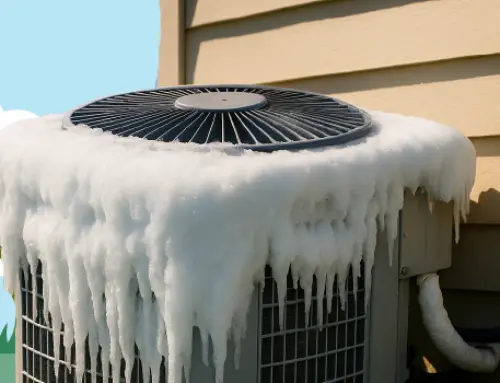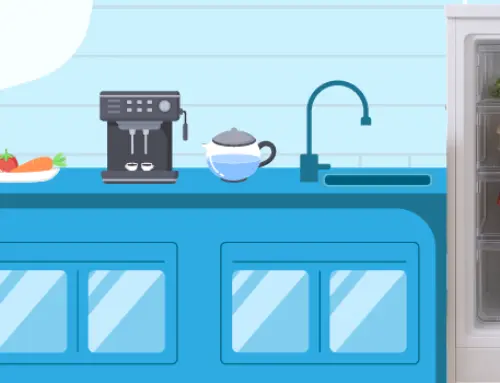How to Prepare for a Long-Term Power Outage in Philadelphia PA
by Tyler Castle
8.5 min read
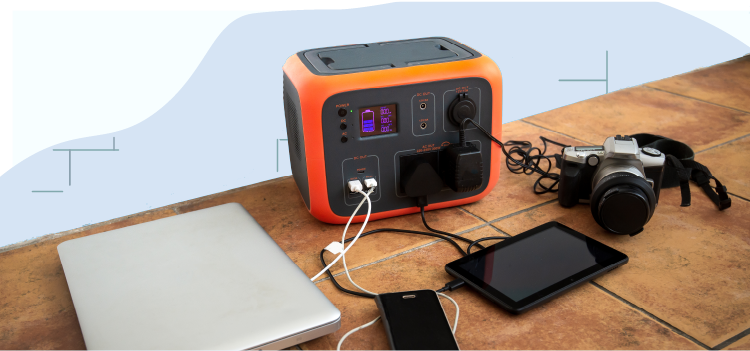
Experiencing a prolonged power outage can be both inconvenient and unsettling, especially when it disrupts your daily routine. No matter how you experience a prolonged power outage, knowing how to navigate these situations is crucial for your safety and comfort.
We’ll explore practical steps to take during an extended power outage. From keeping yourself comfortable, to staying connected with essential services, we’ve got you for whatever you endure. Being prepared not only helps you maintain peace of mind but also ensures that you can weather the storm—literally and figuratively—with resilience.
What causes power outages?
In contrast to rolling blackouts which are typically planned by grid managers, power outages occur without warning. Power outages happen more often than you think. In 2022, states like Pennsylvania ranked number six for the most power outages. These accidents can happen for numerous reasons but here are some of the most common:
Weather-related outages related to natural disasters like snowstorms, rain, and hurricanes are the most common. With climate change contributing to more frequent and intense weather events, the likelihood of power outages is set to increase. Not surprisingly, 80% of power outages that occurred from 2000 to 2023 were caused by weather. Usually, when bad weather occurs, mechanical failures and vehicular accidents lead to power outages.
Number of Weather-Related Power Outages from 2000 – 2023
| State | Number of Outages |
|---|---|
| Michigan | 157 |
| Ohio | 87 |
| Pennsylvania | 82 |
| Illinois | 70 |
Even on days when bad weather isn’t on the radar, prolonged power outages can occur because of human error. Accidental damage from construction activities or vehicular accidents can disrupt power lines.
In the same way, animals aren’t excluded from being the cause of power outages either. Wildlife, such as squirrels or birds, can interfere with electrical equipment, causing outages. For instance, squirrels chewing on power lines or birds nesting on electrical transformers can lead to disruptions in the power supply.
In city areas where electricity is widely used, power outages can occur. During hours of high electrical demand during peak usage times can overload the system, leading to blackouts. Additionally, the dense concentration of infrastructure in urban environments increases the likelihood of equipment failures and so can an outdated power grid.
How long does a power outage last?
Typically, power outages are categorized into two types:
Short-term outages: Typically lasting a few minutes to several hours. These are often caused by temporary disruptions like minor equipment failures or small-scale weather events.
Prolonged outages: Can last several days to weeks, usually resulting from major natural disasters or significant damage to the power grid infrastructure.
According to the E.I.A, in 2022, the average U.S. electricity customers averaged five and one-half hours of power interruptions. How long power outages last in your area will vary depending on your location, the size of your power grid, and the severity of the issue causing the outage.
Are partial power outages dangerous?
Partial power outages can be considered dangerous depending on the severity. In some cases, only certain circuits or appliances may lose power. This can create hazards such as inconsistent lighting, compromised security systems, or malfunctioning heating and cooling systems.
Partial power outages can cause appliances to malfunction, leading to electrical fires or damage to the devices. They can also create unsafe conditions if essential systems like heating or medical equipment fail. Crucial appliances like smoke alarms and carbon monoxide detectors could lose power and lead to danger.
While we can’t predict when outages occur, during bad weather, unplug appliances like coffee makers, air fryers, and single-use items to prevent them from blowing out. Be sure to disconnect affected appliances and use alternative power sources or backup generators if necessary.
What to do during a power outage
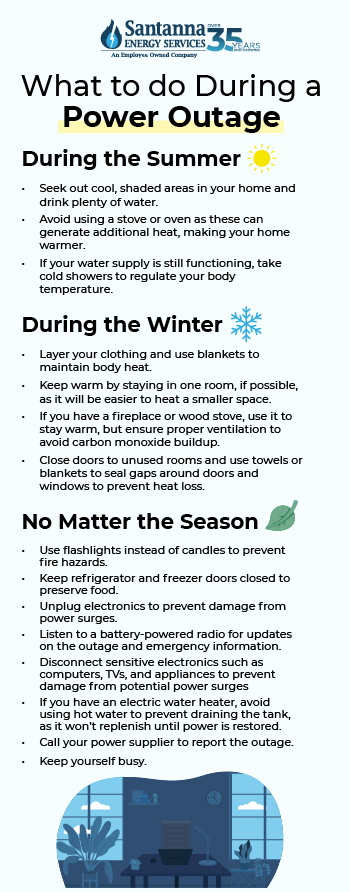
Even if you live in an area where outages aren’t common, it’s a good idea to know what to do when a power outage occurs. Here are some tips on what to do during this situation:
During the summer
- Seek out cool, shaded areas in your home and drink plenty of water to stay hydrated.
- Avoid using a stove or oven as these can generate additional heat, making your home warmer. Opt for cold meals or preprepared snacks instead.
- Power outages can affect water supplies. If your water supply is still functioning, take cold showers to regulate your body temperature.
During the winter
- Layer your clothing and use blankets to maintain body heat.
- Keep warm by staying in one room, if possible, as it will be easier to heat a smaller space.
- If you have a fireplace or wood stove, use it to stay warm, but ensure proper ventilation to avoid carbon monoxide buildup.
- Close doors to unused rooms and use towels or blankets to seal gaps around doors and windows to prevent heat loss.
No matter the season
- Use flashlights instead of candles to prevent fire hazards.
- Keep refrigerator and freezer doors closed to preserve food.
- Unplug electronics to prevent damage from power surges.
- Listen to a battery-powered radio for updates on the outage and emergency information.
- Disconnect sensitive electronics such as computers, TVs, and appliances to prevent damage from potential power surges
- If you have an electric water heater, avoid using hot water to prevent draining the tank, as it won’t replenish until power is restored.
- Call your power supplier to report the outage.
What to do during a power outage at night
Power outages can happen at night when you don’t expect it. Usually, power outages are indicated by beeps and noise. If you wake up and suspect there’s an outage in your home, do the following:
- Use battery-powered lanterns, flashlights, or headlamps. Avoid candles due to fire risk.
- Ensure all family members, including pets, are safe and accounted for.
- Secure your home by locking doors and windows. Consider using battery-powered security lights or alarms.
- Keep refrigerator and freezer doors closed to preserve food.
- Unplug electronics to prevent damage from power surges.
- Call your power supplier to report the power outage.
How to prepare for a long-term power outage
Preparing for a long-term power outage involves thorough planning and stocking up on essential supplies to ensure safety and comfort.
Start by compiling an emergency kit that includes non-perishable food, batteries, lighting, bottled water, first aid, and clothing. Stock up on at least a month’s worth of food and water, the average person needs 2.7 liters a day. And be sure to set aside a few clean changes of clothing for long-term power outages too as electric washing machines won’t function during this time.
Prepare your home for what’s to come by keeping windows and doors closed during power outages caused by natural disasters. If you believe you’ll be subject to a long-term power outage in the winter, take steps to winterize your home to prevent heat loss. Things like adding extra insulation and caulking drafts and air leaks can make all the difference.
Before your long-term outage happens, it’s a good idea to stock up on alternate lighting. Having multiple flashlights, emergency candles, or oil lamps can make nighttime less hazardous.
While you’re stocking up, consider purchasing a home generator. Home generators are essential for producing backup power. However, these generators can emit carbon monoxide and if used incorrectly and not properly ventilated can lead to death.
Most importantly, if you’re in an area that’s prone to outages, keep yourself engaged and have a game plan for loved ones. Read books and play games to stay busy and connected with family during outages. If you have a pet, stock up on their food too and connect with family members beforehand to ensure their safety.
Tips and tools
Be sure to utilize your refrigerator reset button. If don’t have one, press and hold the Power Cool and Power Freeze buttons for 5-10 seconds to reset your system. Note that the exact reset process will vary based on your model.
Food in the refrigerator can stay safe for up to 4 hours if the doors remain closed. Use coolers and ice packs if available to store extra food. If you have access to ice or snow, use it to keep coolers and ice chests cold. Place ice in the cooler and put perishables on top to help maintain a lower temperature.
In the freezer, group items together to help them stay frozen longer. The mass of frozen food helps maintain the cold temperature when the power is out. If you have perishables, label, and date all food items to help you track which items need to be used first or discarded.
Contact your utility provider to report the outage and get updates on the estimated restoration time.
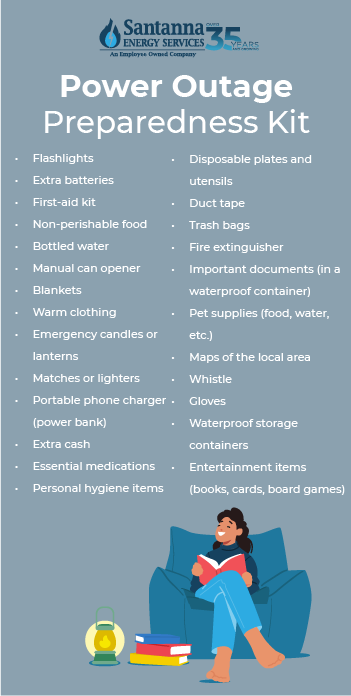
FAQs
What should I throw out of the freezer after a power outage?
After 4 hours of being in the fridge without any power, we recommend throwing away the following:
- Meat
- Poultry
- Fish
- Eggs
- Milk
- Leftovers
How long does food last in a power outage?
According to FoodSafety.gov, your fridge will keep your food safe for up to 4 hours. Keep your door closed as much as possible. If you have doubts about anything you’re about to eat, throw it out; it’s better to be safe than sorry.
Are rolling blackouts and power outages the same?
Rolling blackouts and power outages both involve a shut-off of electricity but are not the same. Rolling blackouts are often scheduled by cities in advance while power outages are without notice.
How long does a power outage take to fix?
While some power outages take a few minutes, some can take longer depending on damage. On average, power outages take 2-3 hours to fix. The of course, depends on your utility provider, location, and severity of damage.
We love our Philadelphia, P.A. customers! Santanna Energy Services has been proudly providing easy home electricity and gas plans to our Pennsylvania customers for over 35 years! We’re proud to offer a wide range of renewable energy solutions and products tailored to meet the unique needs of our customers. Our mission is to provide innovative and cost-effective energy solutions that will help our customers achieve their energy goals and help the environment along the way.
Tyler is an experienced energy professional, having worked for Santanna Energy Services, for the past four years. He is passionate about renewable energy and believes that diversifying the energy grid is the key to a sustainable future. Tyler is dedicated to supplying consumers with the best possible energy solutions and works diligently to make sure that Santanna can deliver the highest quality service.




